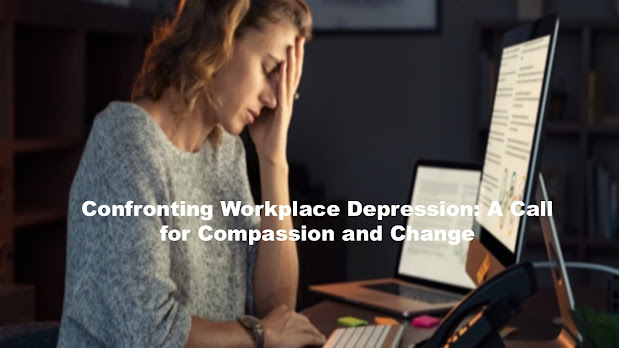Workplace Depression: A Call for Empathy and
Action
In today’s fast-paced and often high-pressure
work environment, workplace depression is an issue that affects more employees
than we may realize. Despite the increasing focus on productivity, deadlines,
and performance, mental health struggles often go unnoticed and unsupported.
This is especially true for those battling depression in silence, afraid of the
stigma that still surrounds mental health in professional settings.
The reality is that workplace depression is
not only common, but it also has profound consequences for both individuals and
organizations. According to the World Health Organization (WHO), depression is
the leading cause of disability globally, with work-related stress contributing
significantly to this statistic. Shockingly, studies show that 76% of employees
experience mental health challenges at work, yet a mere 10% feel comfortable
discussing these issues with their employers. The economic impact is staggering,
with depression and anxiety resulting in a loss of approximately $1 trillion
annually in global productivity.
Understanding
the Roots of Workplace Depression
Several factors contribute to workplace
depression, and it’s important for both employers and employees to recognize
them:
- Excessive Workload: An
overwhelming number of tasks, tight deadlines, and constant pressure can
lead to burnout, a precursor to depression.
- Lack of Recognition: When
employees feel undervalued or unnoticed for their hard work, it can create
a sense of disconnection and disengagement.
- Toxic Work Environment:
Negative workplace dynamics, such as bullying, conflicts, or poor
leadership, can create an atmosphere of constant stress, exacerbating
mental health struggles.
- Work-Life Imbalance: When
professional obligations overshadow personal well-being, emotional
exhaustion can quickly set in, leading to burnout and depression.
- Isolation in Remote Work: The
shift to remote work, while offering flexibility, has left many employees
feeling isolated and disconnected from their colleagues and support
networks.
Real
Stories of Resilience
While workplace depression can feel isolating,
many individuals have found ways to overcome it, and their stories offer
inspiration for others:
- Sarah’s Journey:
Sarah, a customer service representative, struggled with depression as her
workload increased during a company restructure. By setting boundaries and
opening up to her manager, she was able to regain a sense of control and
balance, ultimately improving her well-being.
- James’s Experience:
James, an engineer, found himself sinking into depression during the
pandemic, avoiding social interactions and distancing himself from his
colleagues. A colleague noticed his isolation and started regular
check-ins, which became a lifeline for James and helped him re-establish
human connections.
- Leila’s Transformation:
Leila, a graphic designer, had struggled with workplace depression for
years. After implementing lifestyle changes such as regular exercise and a
healthier diet, she felt her mood lift and gained the strength to address
her workload concerns with her manager.
Practical
Strategies for Overcoming Workplace Depression
Whether you’re an employee or an employer,
there are practical steps you can take to combat workplace depression:
For Employees:
- Prioritize Physical Health:
Engage in regular exercise, eat a balanced diet, and get sufficient sleep
to boost mood and energy levels.
- Set Boundaries:
Communicate your limits and avoid overextending yourself. Taking breaks
and disconnecting after work is essential for maintaining a healthy
work-life balance.
- Seek Support:
Therapy or counseling can provide tools to manage stress and navigate
challenges in the workplace.
- Build Connections:
Reach out to colleagues and create a network of support, whether through
virtual coffee chats or in-person conversations.
- Practice Mindfulness:
Techniques like meditation or journaling can help manage stress and
improve emotional resilience.
For Employers:
- Foster a Supportive Environment:
Offer resources such as Employee Assistance Programs (EAPs) and encourage
employees to seek help when needed.
- Normalize Mental Health Conversations: Open up discussions around mental health and lead with empathy.
This helps break the stigma and fosters an environment of understanding.
- Encourage Work-Life Balance:
Provide flexible working arrangements, encourage time off, and ensure
employees have the time to recharge.
- Train Managers:
Equip leaders with the tools to identify signs of depression and how to
respond in a compassionate and supportive manner.
- Recognize Achievements:
Acknowledge and reward hard work to boost morale and foster a sense of
accomplishment.
Conclusion:
Creating a Resilient Workplace
Workplace depression is not just an individual
challenge but a collective responsibility. By recognizing the signs, fostering
a supportive environment, and implementing proactive strategies, organizations
can create workplaces where employees feel valued, understood, and mentally
healthy.
As demonstrated by the stories of Sarah,
James, and Leila, recovery is possible when compassion, connection, and change
are at the heart of our workplace culture. Let’s work together to build
resilient workplaces that support mental health and well-being, benefiting both
employees and the organizations they serve.


